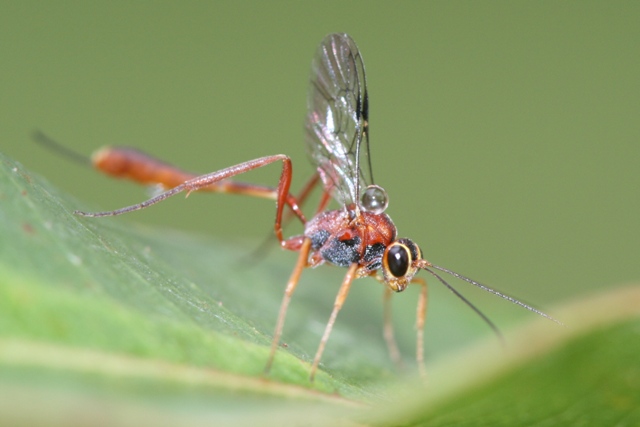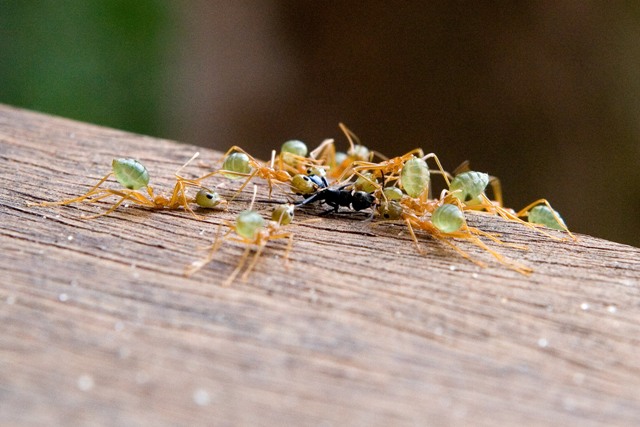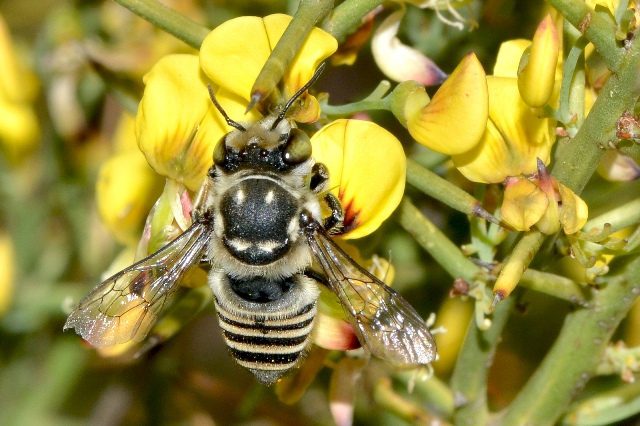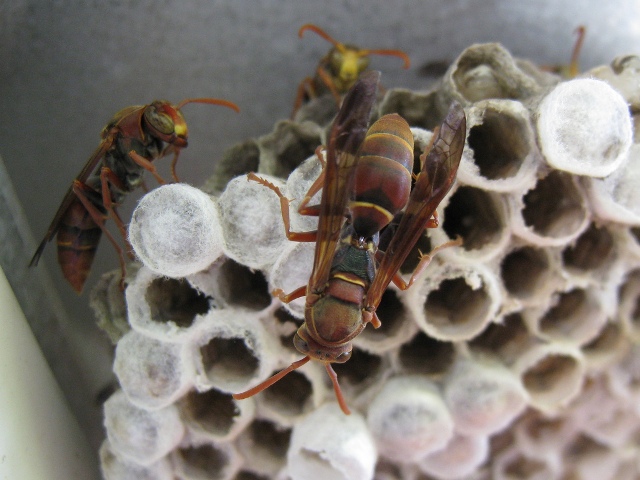Phylum Arthropoda
Subphylum Hexapoda
Class Insecta
Order Hymenoptera
Common names: ants, bees, wasps, sawflies
Overview
The Hymenoptera are one of the most frequently encountered and numerically and biologically diverse insect orders. The group is divided into two suborders: the Symphyta (sawflies) and the Apocrita (ants, bees, wasps). The morphology of apocritan wasps differs markedly from that of the Symphyta: Apocrita have a pronounced constriction or waist between the first and second abdominal segments that clearly divides the body into two regions (often called the mesosoma and metasoma), whereas sawflies have no such �wasp waist�. Other general characteristics of Hymenoptera include chewing (mandibulate) mouthparts and two pairs of membranous wings, the forewings much larger than hindwings. The forewings have less than 20 cells, and in small species this is reduced to just a few cells or none at all. Many Hymenoptera also have wings that are reduced (brachypterous) or absent (apterous). Females have an ovipositor, which, in most Hymenoptera is used for egg-laying. In parasitoids, the oviposition fluid includes a venom that stops host development or may interfere with the host's immune system, allowing continued host growth. The ovipositor may be short and concealed or long and exposed. In some groups the ovipositor is modified, forming a sting that delivers venom to deter potential predators and protect the colony or to paralyse prey. Typically, apocritan larvae lack external features and are grub-like. Sawfly larvae are usually free-living on plants and may be mistaken for caterpillars (lepidopteran larvae) except that they only have three pair of legs, and no prolegs.
Distribution and diversity
Hymenoptera comprise a significant proportion of the arthropod diversity in most terrestrial habitats across the globe. They are one of the four mega-diverse orders of insects, along with the Coleoptera, Diptera, and Lepidoptera. About 120,000 species are described worldwide, however the true size of the order might be as much as five times this number. Nearly 11,000 described species in 67 families are recorded for Australia, but this is likely to be only about one-fifth of the continent�s fauna.
Life cycle
The Hymenoptera are best known for three broad life-histories: 1) parasitoids, in which the female oviposits into or onto the juvenile stages of other insects and arachnids, and the larva then feeds on the host to complete its development, ultimately killing the host; 2) eusocial Hymenoptera, in which the eggs are laid by a queen and the larvae are cared for in large communal nests that have a reproductive division of labour; and 3) phytophagous Hymenoptera, larvae of which feed on wood, foliage, seeds and sometimes cause galls. The order is also characterised by having a highly specialised form of parthenogenetic reproduction. All Hymenoptera have a form of reproduction called arrhenotoky (or haplodiploidy), in which mated females produce only (diploid) female offspring and unmated females produce only (haploid) male offspring. In many cases, mated females can withhold sperm from an egg as it passes down the oviduct; the offspring from the unfertilised egg develops into a male. Thus, some female Hymenoptera are able to select the sex of their offspring. After hatching, larvae develop through several moults before pupation.
Feeding
Hymenoptera have mandibulate mouthparts and the range of food eaten reflects the diversity of the group. Larval parasitoids feed internally or externally on the body fluids and organs of their hosts. Ants may be opportunistic generalists, preying on or foraging for any available food source including seeds, nectar, arthropod prey, carcasses, and carbohydrate rich exudates from specialised plant nectaries or honeydew from plant-feeding leafhoppers or aphids (Hemiptera) or lepidopteran caterpillars. Others are more specialised, harvesting seeds or �farming� other insects or fungi. The larvae of many phytophagous species feed on wood, foliage, seeds and sometimes induce galls, while the adults of many bees and wasps, including predatory and parasitic species, feed on nectar or pollen.
Ecology
Hymenoptera are ubiquitous, occurring from forests and woodlands to grasslands and wetlands, freshwater and intertidal zones to urban parks and gardens. Due to the group's diverse biology and ecology, few other insect orders play such key roles in the functioning of both natural and agricultural ecosystems. Wasps regulate insect populations though predation and parasitism. The often high levels of host specificity of parasitic wasps have resulted in their use as biological control agents of a large range of agricultural and horticultural pests. The provisioning of nest cells and feeding of larvae with nectar and pollen by bees has resulted in the evolution of an intimate relationship with many flowering plants as pollinators, making bees one of the most important pollinators of flowering plants, including many crop species, particularly by the introduced honey bee, Apis mellifera. Ants dominate many terrestrial landscapes, particularly in Australia, where they are involved in important ecological processes such as predation, seed dispersal and soil health. Because of their ecological importance, ant communities are used extensively for environmental assessment to evaluate and monitor ecological disturbance and land management practices such as fire, grazing and habitat rehabilitation and restoration.
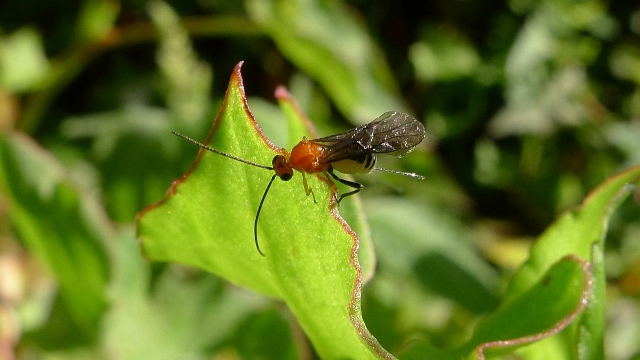
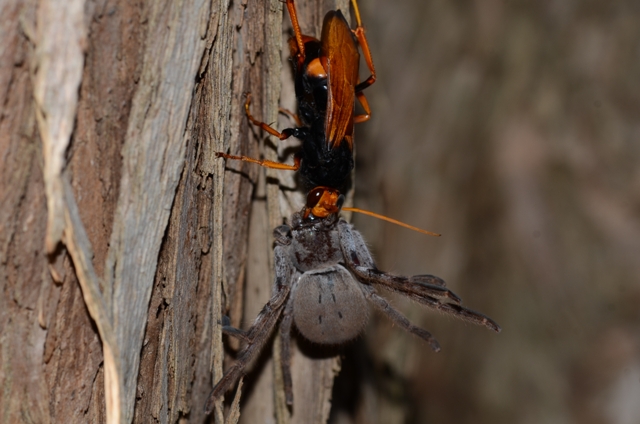
Pompillidae wasp with spider prey
Image credit: � John Jennings
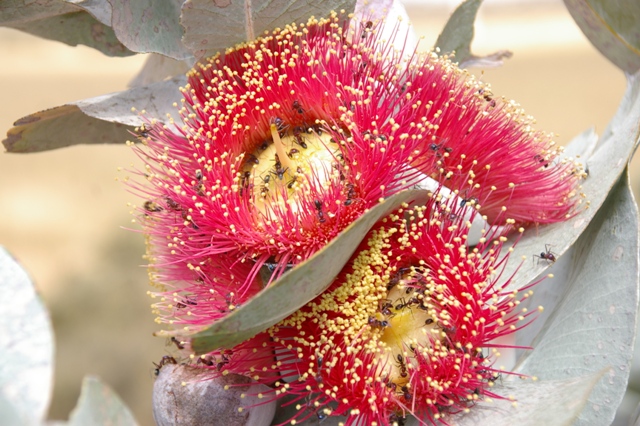
Meat ants on Eucalyptus, Western Australia
Image credit: � John Jennings
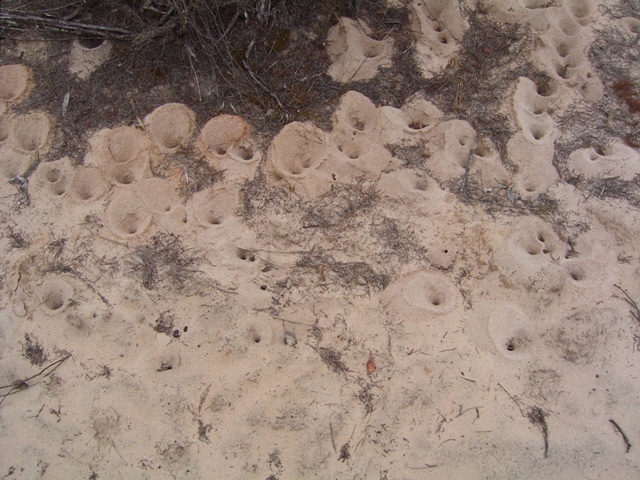
Ant nests, South Australia
Image credit: � John Jennings
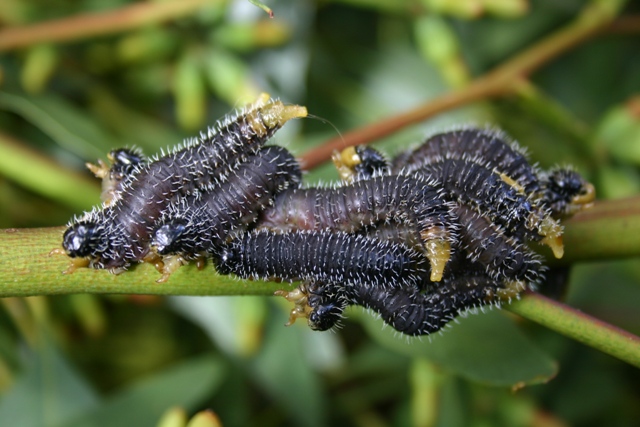
Sawfly larvae
Image credit: Photographer: Mark Harvey
� Western Australian Museum

